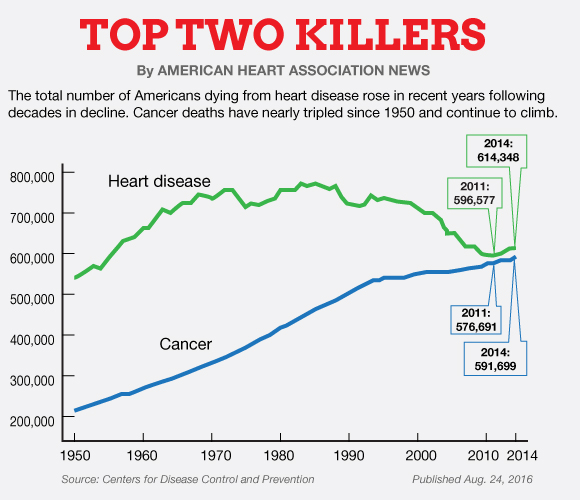Health problems of today’s older citizens began in their youth.
It is no secret that our physical abilities decline with age. Biologically we peak at about age 30 and go downhill from there, but at vastly varying rates depending on factors largely under our own control. We can’t do much about our genetics but we can do a lot on our own to slow down the aging process, and perhaps even mitigate a less than favorable genetic legacy.
 Nevertheless, it is not easy. An overriding characteristic of people who successfully beat the odds is willpower. Research has shown that willpower starts early on in life and affects everything we do thereafter. Where does the power of willpower come from? To find out, you can read the book by Roy Baumeister and John Tierney. The good news is if you don’t have willpower since birth or you didn’t learn it somewhere along your path to senior citizen status, it’s not too late to learn, just a lot harder. And Baumeister and Tierney give us shortcut to enjoying a lot of the benefits of willpower. “You could sum up a large new body of research literature with one simple rule:
Nevertheless, it is not easy. An overriding characteristic of people who successfully beat the odds is willpower. Research has shown that willpower starts early on in life and affects everything we do thereafter. Where does the power of willpower come from? To find out, you can read the book by Roy Baumeister and John Tierney. The good news is if you don’t have willpower since birth or you didn’t learn it somewhere along your path to senior citizen status, it’s not too late to learn, just a lot harder. And Baumeister and Tierney give us shortcut to enjoying a lot of the benefits of willpower. “You could sum up a large new body of research literature with one simple rule:
‘The best way to reduce stress in your life is to stop screwing up’.”
We have become a nation of overweight people with all the attendant ailments that accompany being overweight, but that is just a small part of the story. The U.S Centers for Disease Control and Prevention (CDC) track the causes of death and researchers around the world try to explain why we are worse off now than in 1950 despite all the science and great medicine.

Because we are living longer, there are more people alive who have heart disease that is being medically managed and is not resulting in death than there would have been 30 or 40 years ago. We all know about the so-called risk factors that doctors warn us about. Risk factors are conditions or habits that make us more likely to develop a disease or make an existing disease worse.
(This Table is Best Viewed in Landscape Mode on Portable Devices)
What Are the Risk Factors | What Are the Risk Factors |
All these risk factors mean is that the more of these that apply to you, the higher the probability is that you will have heart disease or cancer. In reality everybody in the United States and probably all of western civilization has heart disease, cancer, or both. The question is when will it kill you or will something else get you first? For example, most old men have prostate cancer, often undiagnosed, but most will die from something else like a stoke or heart attack.
There are numerous questions about the risk factors that render them almost meaningless with a few notable exceptions. Having a healthy diet and being physically active, maybe in the reverse order, are the keys to Active Aging and Wellness.
Smoking is an obvious screw-up and is a classic example of lack of willpower.
Being overweight is more complicated because it involves more than just lack of willpower. The same can be said for diabetes and insulin resistance.
Women have a genetic advantage against heart diseast because of hormones but after menopause hormone replacement therapy may be a risk factor for some cancers.
A family history of heart disease is clearly genetics. Blood cholesterol level, also highly genetic and while correlating with heart disease, does not cause heart disease. In fact research shows that primary prevention using statins to reduce cholesterol levels does not correlate with significantly better outcomes.
“The cholesterol-heart attack link and the achievement of lowered cholesterol
without protective effect is an important scientific puzzle.”
We cannot spend ourselves into better health.
The statistics for healthcare spending in the United States are shocking considering that our outcomes do not measure up to many other countries that spend less and have better health and longevity. We spend a greater percentage of our gross domestic product (GDP) than any other nation, yet we rank number 42 in longevity. (CIA)
What`s going on here?
We think we know the answer but we do not have a solution for the entire nation. It has to begin with one person at a time.
Food Distribution System
We are a nation dominated by a consumer economy. The four components of what the country produces, our gross domestic product (GDP) are personal consumption, business investment, government spending, and net exports. Almost seventy percent of our current economy is personal consumption. In 2015 consumers spent 12.5% of their after tax income on food.
Our Federal Government is heavily influenced by large commercial interests who lobby for regulations that ostensibly protect the public but often have the effect of simply locking out small or new competitors. This is a reason to remain skeptical about the government’s ability to protect us.
Regulations governing food quality and those governing labeling and nutritional information are largely self- enforced by growers and food processors. Agriculture is subject to many regulations both federal and state. The idea is to produce clean, healthy food free of contaminants. While great progress has been made cleaning up the food chain in the U.S., there is still room for improvement. Caught between producing foods that look good and killing off pests that destroy quality and yields, producers may opt to push the limits on the use of chemicals to protect their crops.
The Environmental Working Group (EWG) is an organization that monitors pesticide residue in produce and publishes their annual Shopper’s Guide to Pesticides in Produce™
If consumers vote with their food expenditure dollars, producers will eventually meet the demand for the type and quality of food they want.
The Green Revolution
Beginning in the early 20th century, agricultural scientists developed cereal varieties, fertilizers, mechanization, and irrigation methods that more than doubled the world’s production of grains and is credited with saving millions of people from starvation. This so-called Green Revolution is not without its downside. As populations continue to grow exponentially, agriculture seeks new ways to increase production. Biotech companies such as Monsanto have taken the Green Revolution to the new Gene Revolution where genetic engineering and organic chemistry are combined for even greater yields and according to some accounts greater uncertainty about the safety of genetically modified food and chemical residues.
Is Monsanto going to be the savior of a starving world or will the company simply enslave farmers in developing countries with expensive patented seed and chemicals? In the U.S., farmers who traditionally clean their own seed and plant the same variety the following year have been subject to lawsuits because patented varieties have found their way ito their crops. Fortunately, the farmers won. Is it conceivable that someday all of the world’s food production will be in the hands of a few huge corporations?
We find ourselves at an uncomfortable intersection of health concerns that may have a large nutritional component and a burgeoning world population that needs food even if of inferior nutritional quality. Corn and wheat account for about 40 percent of the world’s food. Close to 85% of the global soybean crop is crushed for oil and meal. Soybean oil is the second most consumed oil in the world after palm oil. Three companies, Monsanto Company, DuPont/Bunge, and Asoyia introduced low α-Linolenic acid (ALA) Roundup™ Ready soybeans, which industry may prefer. Because soy oil is cheap, it is found in a vast number of products: salad dressings, margarine, shortening, mayonnaise, frozen foods, imitation dairy and meat products, and commercially baked goods.
Creating a demand for less than nutritious food
Food companies create food products that taste good and are easy to market. Advertised heavily in the media, they have long shelf lives and are easy to transport. Above all, they are safe from any immediate and easily identifiable hazards or contamination. In our highly litigious society, foods are designed to cause no immediate, easily identifiable harm even if chronic use may contribute to obesity or diseases that have a nutritional component. Pesticide or herbicide residues cannot be constantly monitored. The Food and Drug Administration (FDA) monitors and enforces pesticide tolerances in raw agricultural commodities and processed foods. The U.S. Department of Agriculture (USDA) does the same for meat, poultry and some egg products. States have their own regulations also. Government is trying
Pesticide or herbicide residues cannot be constantly monitored. The Food and Drug Administration (FDA) monitors and enforces pesticide tolerances in raw agricultural commodities and processed foods. The U.S. Department of Agriculture (USDA) does the same for meat, poultry and some egg products. States have their own regulations too. Government is trying to protect the food supply but the sheer volume of products is impossible to effectively monitor.

Frozen Confection Aisle in Large National Chain Grocery Store
Twinkie® Nutrition
Everybody knows if you eat Twinkies® you will get fat and die. But Professor Mark Haub, head of the food, nutrition, dietetics, and health department in the College of Human Ecology at Kansas State University went on a Twinkie® diet about ten years ago and he is still alive to wonder why he is still alive.
Actually, he reached a rather mundane conclusion: calories count. At the time he did his experiment, he wasn’t old enough to join AltARP so we assume he had a lot of physiological resilience. He limited his intake to 1,800 calories per day, kept up an active lifestyle, ate a little protein and a few vegetables, and shed 27 pounds in 2 months. His study was a N=1 trial, which has little relevance for the rest of us except for his conclusion: Calories count.
The Key to our Strategy for Active Aging and Wellness, with Thanks to a Pioneer Physician

Beratzhausen (Upper Palatinate, Bavaria): Paracelsus monument. In the small town where Paracelsus lived for some time and in 1530 wrote two of his main works.
Paracelsus (1493–1541) was an early sixteenth century Swiss physician, alchemist and astrologer during the time of the German Renaissance. His full name was Philippus Aureolus Theophrastus Bombastus von Hohenheim, which is not really important to know, but we feel we should honor him by his full name because he recognized something that is relevant to the world he did not know, ours. He made significant discoveries in chemistry that led him to a great insight for which he is remembered in our time as the Father of Toxicology. He is credited with the adage that expresses the basic principle of toxicology, “Alle Dinge sind Gift, und nichts ist ohne Gift; allein die dosis machts, daß ein Ding kein Gift sei” which translates as, “All things are poisonous and nothing is without poison; only the dose makes a thing not poisonous.”
But what has been overlooked in his popularly quoted writings is the next sentence. “Zum Exempel: eine jegliche Speise und ein jeglich Getränk, wenn es über seine dosis eingenommen wird, so ist es Gift; das beweist sein Ausgang.”
“As an example: Any food, and any drink, when taken to excess is poisonous; the proof is in the outcome”
At a time when scholars traditionally wrote and lectured in Latin, Paracelsus gave his lectures in his Swiss-German dialect. Apparently, he was a difficult person with whom to relate. He fought with his publishers and most of his writings were published after his death. Some were translated into standard German of the time and even into Latin, then subsequently re-translated into various other languages. Variations among editions of the same material have resulted in confusion about which writings are entirely by his own hand and which contain interpolations by others. He was a colorful nonconformist who engendered both hostility and envy during his lifetime and for centuries after his death.
In addition to recognizing the relationship between dose and toxicity, Paracelsus also recognized that small doses taken over a long time may be either toxic or as he speculated curative.
We are confident that the above quotes are correctly attributed. They are found on page 23 of Paracelsus’ Seven Defenses as published by Will-Erich Peukert in 1965 and available HERE as a PDF file.
We will discuss our strategy for Active Aging and Wellness after a brief discussion of human physiology.
Physiology of Old People
We can argue about the insensitivity of calling someone old or even the definition of old. But old is what happens when you are still alive. When you were twelve, you anxiously awaited getting older so you  could become a teenager at age thirteen. Then you didn’t think too much about the passing years until age forty, the big 4-0, was staring you in the face. And when you stared back at your own face in the mirror, you noticed a few changes. Perhaps friends gave you a birthday party decorated with black balloons. By age 50, your friends were getting older too so instead of teasing you about getting old, they celebrated that you have mutually survived so long and perhaps even learned a thing or two along the way. At about age 50, you start getting your letters in the mail from AARP, so there is little doubt that you should give it all up and retire. But in spite of your senescence, you don’t feel that old, especially inside your head, and actual retirement is years away.
could become a teenager at age thirteen. Then you didn’t think too much about the passing years until age forty, the big 4-0, was staring you in the face. And when you stared back at your own face in the mirror, you noticed a few changes. Perhaps friends gave you a birthday party decorated with black balloons. By age 50, your friends were getting older too so instead of teasing you about getting old, they celebrated that you have mutually survived so long and perhaps even learned a thing or two along the way. At about age 50, you start getting your letters in the mail from AARP, so there is little doubt that you should give it all up and retire. But in spite of your senescence, you don’t feel that old, especially inside your head, and actual retirement is years away.
Is there a way to quantitatively measure aging? An autopsy is a reliable way to measure aging but its not something you want. However autopsies on people of all ages have shown that normal aging affects all physiological processes of the body and measurable changes can be seen by the third and fourth decades of life. Aging also seems to progress at a fairly constant rate albeit at imperceptibly different rates for different people. Aging is largely determined by your genes but also heavily influenced by exterior environmental factors like exercise and diet. In fact exercise and diet starting in childhood can affect how we age later in life. Environmental factors also influence gene expression, so ultimately all physiological changes are genetic, it’s just a question of what pushed a gene in a particular direction or did it happen spontaneously?
Studies of Identical Twins reveal Effect of Environmental Factors
Numerous studies of identical twins demonstrate how habits, lifestyle, diet, and disease can result in dramatically different outcomes for people with the same basic genetic legacy. These links to pictures and slide presentations are interesting but it is difficult to draw specific conclusions except what is already obvious. A twin who doesn’t smoke shows less aging and has fewer chronic health problems. The twin who leads a more seure life and doesn’t engage in risky behavior is likely to age more slowly and probably live longer.
http://www.nytimes.com/slideshow/2009/02/05/health/agingfaces_well_slideshow_index.html
http://jamanetwork.com/journals/jamadermatology/fullarticle/654484
Changes in Organ Systems with Age
It is often difficult to separate normal changes in the body’s organs from changes aggravated by external factors such diet, exercise, infections or environmental contaminants. Autopsies of young people show heart disease starting as early as age 15. Atrophy, the gradual wasting away of the cells that make up our organs is common to all organs. It can be caused by physical damage (eg. radiation), loss of nutrition, loss of hormonal support, or loss on innervation among other causes.
Skin
Skin is the largest organ of the body. It has three layers and changes to all three layers occur with aging. The outer layer, the epidermis, readily shows atrophy. Physically the epidermis becomes thinner and the rate that cells regenerate takes longer. A blister in a teenager heals twice as fast as a 65-year-old. The dermis is what supports the epidermis and in addition to atrophy, it can become calcified and loses its elasticity allowing the skin to sag and wrinkle.
Heart and Vascular System
The output of the heart decreases about one percent per year after age 30 without heart disease. In persons with diagnosed heart disease, the decrease is even greater. Blood pressure increases with age and there is a progressive stiffening of the arteries. At autopsy, over 70% of people show amyloid deposits in their hearts. Primary systemic amyloidosis predominantly affects the heart. Amyloid is a starch-like protein that can be deposited in multiple organs (eg, heart, liver, kidney, skin, eyes, lungs, nervous system). See the MedScape site for an in-depth discussion of Cardiac Amyloidosis.
Lungs
Starting at about age 20 the vital capacity of the lungs decreases about 26 milliliters (ml) per year for men and 22 ml for women. Over a lifetime, the lungs become less elastic so there is a 20-30 percent reduction in the maximum voluntary expiration per second. Aging lungs are more susceptible to pneumonia, both bacterial and viral. Older people should avail themselves of recently available pneumonia vaccines.
Kidneys
The volume and weight of kidneys decrease with age so that at age 80-90 kidneys are only 70% as large as at age 30. Because kidney size and the number of glomeruli decrease with age, older people are not as able excrete certain drugs, which can complicate treatment. The elderly often lose their sense of taste and smell and consequently don’t drink as much water as they should, further aggravating the kidneys’ ability to excrete waste.
Bladder
The size of the bladder decreases with age from about 500-600 ml at age 30 to as little as 250-600 ml for people over 65. Urinary incontinence affects about 17 percent of men and 23 percent of women over 65.
Stomach
The days of the cast iron stomach disappear rapidly with age. Seniors need to adjust the amount of food they eat at at one sitting to compensate for atrophic gastritis , which increases significantly with age. It is a condition that should be treated by a gastroenterologist to eliminate easily treated but potentially dangerous disease states. Ulcers used to be the scourge of old people but now an infection caused by the H. pylori bacterium discovered in 1982 can be eliminated with antibiotics.
Intestines
A decrease in intestinal motility and digestive secretions occurs with age. Laxative abuse is the most common cause of diarrhea in the elderly. The treatment of choice for intestinal problems is to maintain healthy gut bacteria, which means eating sufficient fiber of the correct type for the bacteria. Inadequate fiber intake has been linked to gastrointestinal disease (constipation, diverticulosis, and irritable bowel syndrome), cancer, coronary heart disease, and metabolic disorders such as diabetes, hyperlipidemia, and obesity. The bacteria in the gut produce essential nutrients for the immune system and so play a role in autoimmune disease.
Menopause
Menopause occurs because of the disappearance of oocytes from the ovary through ovulation and follicular atresia. After menopause, women loose some of the protection against heart disease that they had previously. Changes in skin also occur because of the loss of estrogen.
Prostate
Instead of shrinking with age, the prostate frequently enlarges causing problems for 90 percent of men by age 80, if they make it that far. About 80% of men at age 80 have cancer cells in their prostates but only one in six will be diagnosed and of those only one in 36 will die from the disease.
Endocrine System
The endocrine system is the collection of glands that produce hormones that regulate metabolism, growth and development, tissue function, sexual function, reproduction, sleep, etc. Most of these glands deteriorate to varying degrees with age. Of critical importance to the metabolism is the way the body handles sugar. Increasing age results in a progressive deterioration in the number and the function of insulin producing beta cells in the pancreas. As beta cells deteriorate, the pancreas makes more proinsulin, an inactive form of insulin. At the same time, peripheral cells, including fat cells, become more resistant to insulin. The percentage of Americans age 65 and older with diagnosed or undiagnosed diabetes is about 25.2%.
A Strategy for Active Aging and Wellness
Key Points:
Practice Willpower
Stay Active
Correct Nutrition
Adequate Sleep
